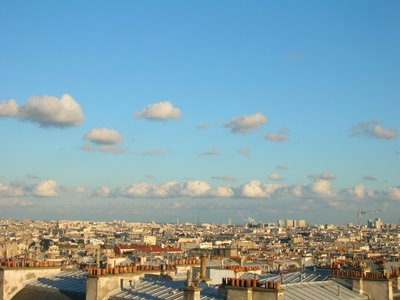30 December 2006
29 December 2006
28 December 2006
27 December 2006
20 December 2006
16 December 2006
A collective work


As a souvenir, a friend held a party before his  depart of Paris and prepared a huge tissue for everyone to put something on. "Remember, the objective to make something jolie (nice)!" His request for everyone who put their hands on the "canvas", then I stick the label of Heineken next to the handprint with three lines... after a fight, I won and the label stayed! The result of this collaborative work is surprisingly beautiful.
depart of Paris and prepared a huge tissue for everyone to put something on. "Remember, the objective to make something jolie (nice)!" His request for everyone who put their hands on the "canvas", then I stick the label of Heineken next to the handprint with three lines... after a fight, I won and the label stayed! The result of this collaborative work is surprisingly beautiful.
11 December 2006
丟了三堵牆的家
 記得以前工作的地方對開的天橋上,總有一個人躲在雨傘底,是男是女也看不出。下午的時候必然會見到他,他從不說一句話,也從不向人要錢,就這樣靜靜地坐在雨傘底。
記得以前工作的地方對開的天橋上,總有一個人躲在雨傘底,是男是女也看不出。下午的時候必然會見到他,他從不說一句話,也從不向人要錢,就這樣靜靜地坐在雨傘底。無家可歸是怎樣的感覺?當全世界的人都唾棄你是怎樣的感覺?要在這樣的環境中活下去又需要怎樣的勇氣?是不是每個人都需要一個家?怎樣才算是一個家?一個人的家是一個家嗎?丟了三堵牆的家還算是一個家嗎?
一堆床褥,一張被子,一塊紙皮當衣
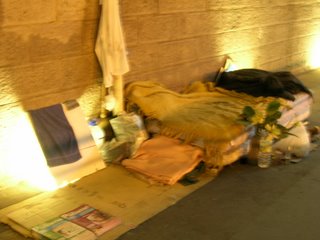 櫃,路燈是座地燈,垃圾箱撿來的塑膠瓶,公園採來的鮮花,他還喜歡燒香,花傍放著一尊佛像,一堆舊雜誌整齊地放在他的書架上。這是最成功的公共空間的家。白天他都不在家,為口忙嘛,晚上他會坐在床上看著路人往來。這是一條天橋底,行人路很寬闊,他佔了三分一,沒有影響別人,離馬路也有點距離。這裡像家那樣全完,沒有人會來搗亂,也沒有人來噓寒問暖。他是一個亞洲人,中年,矮小,有點胖,乾乾淨淨的,愛穿牛仔褲和一件紅色風褸。
櫃,路燈是座地燈,垃圾箱撿來的塑膠瓶,公園採來的鮮花,他還喜歡燒香,花傍放著一尊佛像,一堆舊雜誌整齊地放在他的書架上。這是最成功的公共空間的家。白天他都不在家,為口忙嘛,晚上他會坐在床上看著路人往來。這是一條天橋底,行人路很寬闊,他佔了三分一,沒有影響別人,離馬路也有點距離。這裡像家那樣全完,沒有人會來搗亂,也沒有人來噓寒問暖。他是一個亞洲人,中年,矮小,有點胖,乾乾淨淨的,愛穿牛仔褲和一件紅色風褸。這張照片是九月拍的,現在他有了個小矮櫃,上面放著一個小型電視機和它那不合比例的巨型天線,即便如此,電視機亦只懂播雪花。
後來,他多了個朋友。一個年輕的黑人,他在他
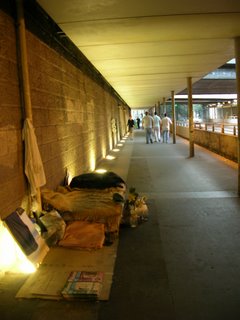 的右邊放了一張床褥,晚上睡在睡袋裡,有時他們會一起坐在床上吃飯,聊天,總是他講話,年青人聽著,點頭或搖頭。有時他們會一起出動,找吃的。再後來,他們找到了一張四人座位的大沙發,放在年青人的右邊,他們同居的家多了個客廳。
的右邊放了一張床褥,晚上睡在睡袋裡,有時他們會一起坐在床上吃飯,聊天,總是他講話,年青人聽著,點頭或搖頭。有時他們會一起出動,找吃的。再後來,他們找到了一張四人座位的大沙發,放在年青人的右邊,他們同居的家多了個客廳。最近,他們又添了個室友,新來的人睡在他的左邊,這人甚麼都沒有,只有一張薄薄的墊子,晚上他冷得很。顯然,這是個新近才成為流浪漢的人,他還沒為自己建立一個家。他們三個人,他老練、不在乎;年青人害怕、痛苦,正跟著他學習流浪的技巧;新來的人絕望、憤怒,他還不能接受這個現實。
我看著那個比我很年輕的人,前面的路這麼長,你就這樣走下去了嗎?
10 December 2006
9 December 2006
一支煙、一個故事
朋友吸著煙,給我講了這樣的一個人。
「那時候香港大學還不是很大規模,藝術系還沒有出現,但有一家獨立的藝術學院,也就是後來的藝術系。那是1966年,就是那個火紅的年代,中國的文革開始鬧得瘋,香港也動盪不安。他醉心於藝術和文學,傾心於中國這個古老的國度,講得一口流利的中文。三十歲出頭,他便從遙遠的歐洲踏上中國的土地。
「有一天,他正在課堂上給十來個學生講解西方藝術史。對他來說,那是個單純的年代,單純的他和他們在暴風雨的漩渦中學習藝術和文學。就在這時,闖進一個槍手,當場殺害了一個學生。原來這個學生是個記者,這個敏感的工作成為了謀殺的動機。他在震驚和不解中深刻地思索和批判,從藝術和文學跳進了政治。此後他多次來往中國,研究中國的當代政治和社會,出版了多部中國研究的書籍,後來,他移居澳洲,在肯培來大學教授中國文學。」
這個人叫Pierre Ryckmans (b.1935),比利士人,以筆名Simon Leys (西蒙‧萊斯) 聞名,是一位傑出的漢學家、作家、翻譯家、史學家、藝術史學家,作品以博學精闢、廣涉中西見稱。
Ryckmans於1970年定居澳洲,1972年重遊中國後,寫下一系列研究文革的書,為了避免被禁入境,他用Simon Leys筆名發表著作。在《主席的新衣:毛和文革》(the Chairman's New Clothes: Mao and the Cultural Revolution)一書中,Simon Leys指出,《文化大革命》除了名稱,毫無革命可言,除了當初計謀上的藉口,毫無文化可言,這是高層一小撮人之間在虛構的群衆運動的煙幕之後的權力鬥爭。毛大權旁落,正是爲了重新獲得權力,他發動了《文革》。而探討中國人權狀況的文章《燃燒的森林》(The Burning Forest : Essays on Chinese Culture and Politics (London : Paladin Grafton Books, 1988) 一文可以在「八九點鐘的太陽」網站找到。
除了對當代社會的研究外,Leys認為要真正認識中國文化和中國人,必需閱讀古著,而從對古著的研究,Leys悟出中國文明的核心是「和諧」,「中國是一種世界觀,是一種構思人與宇宙關係的方式,一劑維持宇宙正常運轉的良方。」中國文化「對西方人想當然地認為具有普遍真實性的各種觀念是一個永久的挑戰,然而實際上這也說明只有在我們自己(西方)的文化範圍內才能找到中國文化的適用之處。」
作為漢學家,Simon Leys的重要貢獻之一,便是翻譯了《論語》這一巨著。Leys的譯版The Analects of Confucius (New York : W.W. Norton, 1997) 是被廣泛譽為較佳的一個版本,早前彭定康在接受英國媒體訪問中就向讀者推薦了Leys的譯版《論語》。我未有機會讀他的書,但在網絡上找到由中國國家圖書館圖研究館員顧犇撰寫的題為《論語在海外的傳播》一文,講解這個譯本的精妙之處 (以下文字轉載自《論》一文)︰
Leys的版本精細且優美,在翻譯中的用詞也很有獨到之處。例如,《論語卷之五‧子罕第九》第25章中的「匹夫不可奪其志也」這一段中的「志」,過去不同的版本都有不同的翻譯。1861年理雅各譯爲 will(意志),英國漢學家阿瑟‧韋利(Arthur Waley)在其1938年的版本譯作 opinion (主張);劉殿爵(D.C. Lau)在其1979年的版本以及雷蒙德‧道森(Raymond Dawson)在其1993年的版本都譯作 purpose (目的);而Leys將這一句譯爲 one cannot deprive the humblest man of his free will,其中「志」譯爲 free will(自由意志)。
又如《論語卷之六‧顔淵第十二》第10章中的「子張問崇德辨惑」,Leys譯作 Zizhang asked how to accumulate moral power and how to recognize emotional incoherence,也就是把「惑」譯成爲 emotional incoherence(情緒不一致)。而在過去,理雅各將其譯作 delusion(欺騙、錯覺),韋利將其譯作 being in two minds(三心二意),劉先生譯作 misguided judgment(被誤導的判斷),道森譯作confusion(困惑)。
Leys的譯本分爲兩個部分,前半部分完全是譯文,後半部分是注釋。其注釋旁徵博引,出現了大量西方文化名人的語錄,他們包括Plato、Pascal、Stendhal、Nietzsche、Marcus Aurelius、Kant、Yeats、Heraclitus等等。例如,在關於《論語卷之四‧泰伯第八》第4章中「曾子言曰:鳥之將死,其鳴也哀;人之將死,其言也善」這一句的注釋裏,有如下這些段落:
「一個人的臨死遺言,就象深沈的音樂一般,有一種自然吸引注意的力量」(莎士比亞《理查二世》第二幕第一場)。在歐洲文化中,天鵝之歌的神話起源于柏拉圖:「天鵝歌唱了一生,當感到死亡將至,它們會更熱情地歌唱」(《菲多篇》,8.5a)。認爲「臨終遺言」具有特殊的智慧,這是人類所共有的信仰,儘管這看來有背於明顯的肉體和心理上的障礙——死亡通常是一件很吸引人注意的事情,它留給人們極少的珍貴時間和精力來簡短地表達自己的思想。
由此可見,Leys的譯本還是一個中西文化比較的産物。在此之前,Leys曾經以自己的原名出版過法文版的《論語》,1998年的西班牙文版也是以他的譯本爲基礎的。
Simon Leys 著作︰
The Death of Napoleon (1991)
The Burning Forest: Essays on Chinese Culture and Politics (London : Paladin Grafton Books, 1988, c1985)
Broken Images: Essays on Chinese Culture and Politics (1979)
Chinese Shadows (1978) 中國大陸的陰影/黃文範譯.--台北市.--中央日報社.--民67[1978]
The Chairman's New Clothes: Mao and the Cultural Revolution (1977)
8 December 2006
錯把香港當伊拉克的人
當時我正在studio排舞,從鏡子中看著自己的一段獨舞,評語是︰「嗯,拍子很準!」中場休息,男舞蹈員很快就散去,兩個朋友臉色驚慌地抱著我的衣服,叫著︰「快跑,有飛彈!」 我卻想起 -- 我家的鎖匙還在更衣室;是,就是這個巴黎南部的小家的鎖匙,我一直在想,我應該找個朋友保管另一套鑰匙,要不然,有一天我忘了或丟了,可就無家可歸。所以,在這十萬火急的時候,我會想起我的鑰匙。
我跑了去出,外面的世界已是一個戰場,人們四處竄逃,卻不知該往哪裡跑,前面是數條縱橫交錯的高架天橋,路邊的草叢一堆堆地燒了起來,我的視線找不到任何一對眼睛,看不到他們的面容,只知道他們驚慌失措。收音機報導說,「他們錯將香港當伊拉克,發了兩個飛彈來。」噢!這可真是世界醜聞!一定要有國際干預,立即停止這種野蠻行為!為什麼我會這樣冷靜?!這時,一個炸彈從我頭頂飛過,像啞呤般的炸彈爆開了,大家驚叫。小小的火花沒有惡意要傷害人,多奇怪﹗
到底發生了甚麼事?誰是「他們」?美國嗎?然後,我看見了他們,一群軍裝的韓國兵,手持機關槍,兇神惡殺。他們想把我們趕到一個甚麼地方,然而他們並沒有要傷害人,他們只要數千人 -- 人質﹗誰給我拋來了一支槍,我開始殺人了。從來沒有玩過 war game的我,這時候近距離開槍殺了幾個韓國兵,他們的頸子捱了子彈,像被藍色的墨汁噴中了一樣的。「原來我不只拍子準,開槍一樣準。」一個小小的聲音跟我說。但為什麼他們不殺我呢?﹗就這樣,我成為了人質,而且是會開槍的人質。
多少時間過去了?我在這個人質營生活了多久?然後,這一晚,門突然打開了,一個人走進來,是李芳,剛認識不久的畫家,她示意我走出去,這是「逃﹗」的意思。我悄悄地走了出去,天呀﹗這不就是《白夜逃亡》的情節嗎?黑夜裡只有點點星光,我站在天橋的一端,另一端數個人影晃動著,兩個人站在橋身的兩邊,中間是一條粗草繩。他們開始撥繩,原來「跳大繩」今天要決定我的生死,我必須通過這個跳大繩測試。我正準備闖過去的時候,左邊的人受指示地轉了半個圈,自己一邊撥一邊跳起來,就這樣,他讓開了天橋給我跑向自由﹗我衝了過去﹗
我四處找藏身之地,在一個看似沒人住的破屋子,有一張榻榻米,我在這裡逗留了半天。天將黑,一群軍人走近屋子,我慌張地躲在榻榻米的棉被中間,他們開始圍在榻榻米上吃飯,我只要一動就會立即沒命。我屏住呼吸,快給悶死了,很想打開被子,呼吸﹗
就在這時,我被自己停止了的呼吸嗆醒了,噢﹗原來做了個惡夢﹗﹗
9時30分了,再不起床就要遲到了。
7 December 2006
小甲蟲和赤祼女體
小甲蟲和赤祼女體 --- 丁珍珍
洗澡間裏
一隻小甲蟲對著一個赤祼女體以及
一場帶肥皂香味的風雨
它橫走 直走
在橫線直線交錯的路標之間
直走 橫走 再轉彎
找不到
躲避風雨的逃逸路線
爬上矮矮的土堆
便傲覽了群山
背著小小的盔甲
便開始夢想戰場
剛有了飛翔的力量
便單槍匹馬闖盪
困在風雨裏
只是不明白
為何運氣這樣的壞
無法看透風雨的範圍
就無法夢想晴天
氣象報告員今早並沒有
預告風雨的方向
雨越來越大漩渦越來越近
直 直 再轉
步伐開始蹣跚它 走 走 走 走再轉彎
橫 橫 轉彎
不幸地摸索進
風雨交加的流域
然後
她走出洗澡間
橫走 直走 再轉彎
4 December 2006
28 November 2006
世界有多大?

今晚的電視突然傳來熟悉的音樂,原來是久違了的「瞬間看地球」﹗第一次在巴黎看到這個聯繫世界的節目,才想起,對呀,世界就是這麼小,地球這一邊的小街在另一邊的我家的14吋小屏幕上出現了,瞬間穿越千山萬水,當你還在街頭數著紅燈的「啲啲啲」時,我已數十萬哩以外的那一個世界看到了你的身影,陪你數著「啲啲啲」。
我不得不佩服構思這個節目的人,是何
 種氣魄,何種視野,令一個人這樣看世界?我們對世界的想像停留在「八十日環遊世界」的獵奇式行為,或某某人在世界的另一端生活,故那個地方和我們發生了關係,而其他的地方於我沒有存在的意義了,那個在花園澆花的陌生人,顯然來自另一個世界。想像那似不相關的國度和我們生活的這個小城市存在於同一個空間、同一個星球的人叫Thomas M. Hohenacker,來自Munich,他要看世界,看它最平凡、最真實的一面,24小時在各個角落發生的日出日落,在後街追著老鼠的小貓,匆匆跳下巴士趕著上班的人群。
種氣魄,何種視野,令一個人這樣看世界?我們對世界的想像停留在「八十日環遊世界」的獵奇式行為,或某某人在世界的另一端生活,故那個地方和我們發生了關係,而其他的地方於我沒有存在的意義了,那個在花園澆花的陌生人,顯然來自另一個世界。想像那似不相關的國度和我們生活的這個小城市存在於同一個空間、同一個星球的人叫Thomas M. Hohenacker,來自Munich,他要看世界,看它最平凡、最真實的一面,24小時在各個角落發生的日出日落,在後街追著老鼠的小貓,匆匆跳下巴士趕著上班的人群。 
從未在這個節目上看見過香港,但原來香港設有兩個鏡頭,一個尖沙咀的 Intercontinental Hotel Cyber Port 的 Hotel Le Méridien。巴黎的鏡頭安裝在 210 米高的 Tour Montparnasse 上端,下次經過Tour Montparnasse 時,抬起頭跟你打個招呼吧﹗
25 November 2006
24 November 2006
17 November 2006
Perhaps Love
It exists to give you comfort, it is there to keep you warm
And in those times of trouble when you are most alone
The memory of love will bring you home
Perhaps love is like a window, perhaps an open door
It invites you to come closer, it wants to show you more
And even if you lose yourself and don't know what to do
The memory of love will see you through
O, Love to some is like a cloud, to some as strong as steel
For some a way of living, for some a way to feel
And someone say love is holding on and some say letting go
And some say love is everything, and some say they don't know
Perhaps love is like the ocean, full of conflict, full of change
Like a fire when it's cold outside, or thunder when it rains
If I should live forever, and all my dreams come true
My memories of love will be of you
-- John Denver
16 November 2006
Adieu Star Ferry!
The World of Suzie Wong (1960)
13 November 2006
鋼筆與紙

這種紙叫european notebook,等同於我們的foolscap paper,但用途及廣泛性有過於而無不及。它有著密密麻麻的線格,粗線的是一個細小正方格,頗適合用於書寫中文字,但細格內再加五條幼線,構成視覺上的眼花撩亂。法國學生每人每年一本,在各大超市、文具店、書店有售,一本約五百頁,上額有虛線,寫滿後可以輕便地撕下,反轉背面繼續書寫,下課後就file進該科目的筆記堆裡,很方便。上學年我也買來了一本玩玩。
前兩天課抄筆記,突然覺自己的筆記順眼多了,好像有甚麼不同了。法文進步了,抄下來的筆記比去年多而整齊了?再細看,噢,原來我用了朋友留給我的foolscap paper,而不是european note﹗怪不得,感覺整齊了。於是,在超市找了兩天,但還找不到foolscap paper,依然是各式各樣的密格子,讓君慢慢爬﹗
這支鋼筆,是羅馬尼亞朋友Catalina送給我的生日禮物,喜歡極了。鋼筆很有傳統學者,或書生的味道,感覺很民初。以前爸爸曾經有一支鋼筆和一樽藍色墨,鋼筆有陣膠味,原來中間的「心」是膠,用來吸墨,有時吸得不好,就會「吐」墨。吸完墨後,要用紙巾抺乾淨筆嘴。現在這支鋼筆,配備refill紙蕊,不但方便易理,還經濟環保,十分實用﹗於是,我用它來作筆記、寫文章、日記、塗鴉,樂此不疲﹗
12 November 2006
8 November 2006
26 October 2006
19 October 2006
Glenn Gould : au-delà du temps
Documentary by Bruno Monsaingeon (France/Canada, 2005, 1h07mn)
13 Octobre 2006 20h30 Auditorium, Musee du Louvre
Glenn Gould plays Bach
Credit: vagifabilov (Norway)
This clip of the young Glenn Gould at practice shows his two most vivid qualities as a pianist -- a genius and an eccentric. Look at the way he hums, the way he moves his hands and his whole body, the way he places his piano, the way he puts his legs, the way he dresses, the way he searches for inspiration, the way his emotions overwhelmed him, the way his fingers flies on the keyboard, the way he stops his practice... nothing is "orthodoxical" as the rules for a classical pianist, in particular, his low position to the piano and his peculiar body movements. He was recognised as one of the greatest pianist of the 20th Century at a young age, but the canon rejected him for the fear of breaking down the so-call "system", another old story in the development of modern and contemporary arts.
Glenn H. Gould (1932 – 1982) is famous for his unique interpretation of Bach's Goldberg Variations. This Canadian pianist loved to hum while he played, his recording engineers once proudly explained how successfully he was able to exclude his voice from his recordings. These hummings for Gould are subconscious singings, and increased proportionately with the inability of the piano in question to realise the music as he intended. In another word, his voice becomes part of the music compensating the techinical problems of his piano.
When he plays, no matter in live performance or in recording studio, he has to bring with him his old chair his father had made even when it was completely worn through. This chair is so closely identified with him that today it was covered in a glass case and is in display in the National Library of Canada.
This genius gave up live performance at the age of 32 (in 1964) and concentrated on studio recording, simply because his piano music is not only for the audience to listen to, but to watch and listen to and move with. That’s why we can see him playing today. It is said that Gould would never play a piece the same way twice. His favorite is Bach, when he plays Bach, it’s not him who’s playing, but Bach himself comes to life. In the documentary, he says while playing The Art of Fugue, "this note is a mistake. Bach would have amended it if he were still alive."
Here comes the most beautiful interpretation of Bach's Goldberg Variations recorded in around 1981. Are you ready for an awesome moment of trance?
Glenn Gould plays Goldberg Variations Aria & var.1-7
Credit: opus3863 (Japan)
18 October 2006
Why not English -- On French as a language (4)
What was France doing at that time? France was first under Napoleon III in the process of Haussmannization of building grand boulevards and glittering cafes, and later the building of the Third Republic. It was all about being "Frenchy", a tag for cultural and identity pride.
Thanks to the Sun King, French had long been the "official language of Europe" unbeatable even by the British Navy. When the cook sportif woke up the country, the American diplomats were already standing in the Hall of Mirror demanding the 1919 Treaty of Versailles to be written in English as well, making the treaty a first in roughly 500 years of European history to have an English version. Should Jacques Chirac had been there, he would have said "No!" to the Americans. Earlier this year, this die-hard advocate of French (against English) stormed a EU meeting because his fellow Frenchman, Ernest-Antoine Seillière, chose to speak English. Why? Because "such snobbery from the leaders of some international companies to speak only the American business language is intolerable."
To the non-French-speaking tourists, Paris is "intolerable"-- no English signs, no English menu, no English local newspaper, no English chanels, no English broadcast...These are absent in the defense of French as a language. The French society and education environment don't encourage English. In scientific and medical researches, for example, France insists on publishing in French, this resulted in a great gap between the country and the world. New adventures and important discoveries remain unique to the francophone countries and incomprehensible to the outsiders. On the other hand, translation is quick to catch up the world trend. Almost all literary work published in other languages, including English, will soonly be translated into French. There is an efficient division of labour, the experts are doing the job so we people don't need to harsh ourselves to read English... even those "elite" students from l'ENS or la Sorbonne choose French translations than English originals, despite the fact that they are Postgraduate researches in the English Department.
However, it doesn't mean the French refuses to speak English. Once the students joined in the workforce, especially in the commerce, they know they have to deguise themselves with an international suit and they are more willing to speak English. In France, l'homme d'affairs, businessmen, do love to speak English, so do the cafe waiters and waitress in their penguin suit! Though it might be politically incorrect to request BBC English from every lips and tongue, the french just love their french accent when they speak English and they strive to keep their french trace, just like all spoiled kids love their milk moustache to remind you that afterall, they are kids!
12 October 2006
8 October 2006
Nessun dorma
This aria from Giacomo Puccini's (1858 - 1924) opera Turandot (1920-1924), was written in 1924 and premiered on 25 April 1926 in Milan with the Spanish tenor Miguel Fleta as the Prince, Calaf. However, it was Luciano Pavarotti (b.1935) who made Nessun Dorma famous!
Here is the version Pavarotti in live in Paris 1998 (12 July, one day after the French championed the World Cup and one day before their National Day). It was a pity that at (1'58" - 2'12") in the video, there should be two lines of chorus which was missing during the performance. It was definitely a producer's faut not to arrange choirs!
Click 2 times on the Play icon, please.
Courtesy: boellebent (Demark)
Nessun dorma! Nessun dorma! (No one sleeps! No one sleeps!)
nella tua fredda stanza guardi le stelle (in your cold room look at the stars)
che tremano d'amore e di speranza... (that tremble with love and hope!)
Ma il mio mistero è chiuso in me, (But my mystery it is locked in me)
il nome mio nessun saprà! (And my name,no one will know!)
No, no, sulla tua bocca lo dirò, (No, no! On your mouth)
quando la luce splenderà! (I will say it, when the light will shine!)
Ed il mio bacio scioglierà il silenzio, (And my kiss will break the silence)
che ti fa mia. (that makes you mine!)
Voci di donne (Chorus):
Il nome suo nessun saprà... (His name no one will know...)
E noi dovrem, ahimè, morir, morir! (And we shall have, alas, to die, to die...!)
Dilegua, o notte! Tramontate, stelle! (Disperse, o night! Vanish, oh stars!)
Tramontate, stelle! (Vanish, oh stars!)
Vincerò! Vincerò! (I will win! I will win!)
Here is another version performed by the famous Three Tenors, Plácido Domingo, José Carreras Coll and Pavarotti in Dodger Stadium in Los Angeles for the 1994 World Cup finals with choirs.
From the lyric, we know that it's not a sad piece of music, but the "heartbreaking" mood is in the melody. This is the opening song of Act III, when the Prince is singing alone on the stage, waiting for the sun to rise and for Turandot to love him. In the background, the Chorus' sombre repetition of Turandot's order that "No one in Pekin is allowed to sleep tonight, until his name is found out" is like a phantom besetting the Prince's hope, like the ghost of Lo-u-Ling waiting for her revenge. Though the prince is hopeful and confident in his words, the chorus lines remind him of the cruelty of Turandot, and his heart sinks (that's why I was upset with the Parvarotti 1998 version). The G major becomes the key signifying "dark hours before sunrise", inspiring the Prince's fear of a failing love and Turandot's terrified avoidance of a marriage with the unknown Prince. Love becomes a war, and everyone is agitated and sleepless tonight.
Turandot (1920 - 1924)
Turandot is the beautiful cold-hearted femme fatale Princess of anncient China, whoever wants to marry her
 must answer her three riddles, either he succeed or he beheaded. In Act I, at night, when the moon rises, the unknown Prince, Calaf, was bewitched by her beauty when she first appeared in the balcony to give death order to the Persian Prince. Calaf stikes three times the gong posing himself as the suitor of Turandot.
must answer her three riddles, either he succeed or he beheaded. In Act I, at night, when the moon rises, the unknown Prince, Calaf, was bewitched by her beauty when she first appeared in the balcony to give death order to the Persian Prince. Calaf stikes three times the gong posing himself as the suitor of Turandot.Act II, Turandot explains in her famous aria In Questa Reggia that her ancestor, Princess Lo-u-Ling, was ravished and murdered by a foreigner, and now out of revenge she has sworn to never let any man possess her. She warns the Prince to withdraw, but he refuses. The Princess presents her riddles:
"What is born each night and dies each dawn?"
"Hope."
"What flickers red and warm like a flame, but is not fire?"
"Blood."
"What is like ice, but burns?"
"Turandot!"
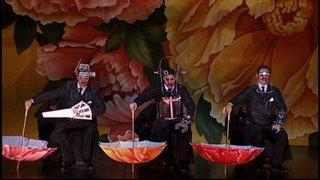
The Prince suceeds and it's Turandot's duty to marry him. Turandot get angry and pleads her father / Emperor not to leave her at the unknown Prince's mercy. The Prince offers her his riddle, "Bring me my name before sunrise, and at sunrise, I will die."
Act III opens with Calaf's Nessun Dorma with the distant repetition of Turandot's order to search for his name. Calaf's maid, Liu, is tortured by the soldiers for the Prince's name. Liu, who loves the Prince, sings, "The name that you seek I alone know." Turandot demands it, Liu answers, "Love", and suicides. Terrified by Liu's suicide and Turandot's cold-heartness, the crowd withdraws leaving Calaf and Turandot alone on stage. Calaf tries to convince Turandot to love him but in vain. He holds her and kisses her, and she feels herself turning towards passion.
Finale: Dawn is breaking, Turandot approaches the Emperor's throne and declares, "His name is .... Love!" (Curtain falls)
The beauty of the Opera is in the enigmatic and poetic of the 3 deadly riddles and the final resolving riddle. Wasn't Puccini irrational in the Prince's dumb move of posing the last riddle to Turandot and giving her a chance to escap and chop off his head?
Well, Calaf doesn't say "Guess my
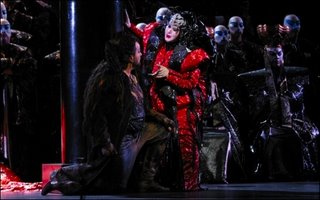 name or you will die" but "Bring me my name and I will die". He actually wants to lose the game since whatever Turandot guesses, it would just be his name. He wants to marry her, of course, but he wants to defeat her cold-hearted defensiveness and have her fall in love with him. He will then die, in the sense of loosing himself completely to her and her love.
name or you will die" but "Bring me my name and I will die". He actually wants to lose the game since whatever Turandot guesses, it would just be his name. He wants to marry her, of course, but he wants to defeat her cold-hearted defensiveness and have her fall in love with him. He will then die, in the sense of loosing himself completely to her and her love.In Nessun Dorma, Turandot hasn't yet figured out all this love poetry business, and still thinks that she just has to get someone to reveal the Prince's name and then she can chop off his head. So she puts out a decree that no one in Pekin is allowed to sleep until the name is revealed.
When Puccini wrote the opera in 1902, it was a period of vexed relationships between China and the Western powers. In Europe, people were fascinated with Chinese art and culture at the same time, afraid of its "barbarism". Puccini's creation of a cruel Turandot while employing the beautiful Chinese folk songs as the musical themes for the opera is a classical love-hatred Western reaction towards China at turn of last century.
According to a interesting musicology study by Johathan Petty and Marshall Tuttle (2001), the Key signature is highly symbolic in the Opera. Throughout Act I, Puccini emphasizes Calaf's D Major (D) as leading tone to Turandot's E Flat Minor (Eb). This is a symbol of a definitive phallic threat from D which she seeks to deny. This threat is made explicit when Calaf rings the gong in D major, releasing energy that abducts Turandot's motif, and incites the Prince to modulate upward into Eb, signifying his surrender to Turandot's imperious beauty, as well the Moonrise and the position of Turandot in the highrise balcony.
In Act II, the solutions to Turandot's 3 riddles occur to the key scheme of D-D-Eb, precisely consistent with the psychological drama of the opera. "Hope" and "Blood" riddles are sung in D, Calaf's signature, "Turandot" riddle is self-evident in the Eb signature.
Then Turandot takes the patriachal C Major to plead to her father, when he insists that she should obey her own law, she crawls from C major up one octave to her father's C.
In Act III, Nessun Dorma starts with the chorus in Turandot's Eb, accending to Calaf's D. The power axis is reversed and thrusts Turandot's Eb and Bb down when the principle melodic material of the aria arrives in D, having released itself from the power of the Eb. And the final climax achieved on the word 'vinceró' is on A, the key which conquered Lo-u-Ling's Fb minor.
Courtesy: FamiliaOrero (Argentine)
This is another version by one of The Three Tenors, Placido Domingo, with The Metropolitan Opera in 1988, here the chorus lines are back and the stage design is wonderful.
This analysis of Petty (2001) gives another aspect of how music articulate psychological changes in the characters. Such as in Nessun Dorma, it's so touch simply because there are some many contradictory moods and emotions going on at the same, they are beyond the description of words but music!
5 October 2006
Esquisses de Frank Gehry (2)
If the purpose of life is to leave trace in human history, the common men's trace presents in their offspring. From generations to generations, his gene passed on through birth and death, and he is remembered.
For an architect, his trace becomes ever-present in the imposing concrete. Be it a scar on your face, or the sacred water baptised on your forehead, you cannot escape its intervention. How big is an architect's ego? He wants a toy for his son, and he wants it to be the biggest, the tallest, and the most long-lived. Look at those most wanted architects today who are building their pantheons at every corner of the world, aren't them the men dispersing their sperms and gene in the planet earth?

Imagine yourself happened to be born a Haussmann in Paris or a Gaudi in Barcelona, would you not walk with a peacock's tail at your back? Whether what your great grandfather left for you is a labyrinth in Paris or a Cinderella's pumpkin castle in Barcelona, you have the biggest toy to marvel at. Only that your home is too small to store your toy!
In My Architect, the introduction reads, " Everyman knows Louis I. Kahn, except one, his son!" So, this illegitimate son looks at the best toys his father prepared for him when he was just some years old. He said to himself, "my father is a great man!" All hatred disappeared, father-son reconciled. How glorious his toys become!
Photo credit:
MY ARCHITECT, Nathaniel Kahn, © 20003 Louis Kahn Project, Inc.
4 October 2006
One Note Symphony
Concert - Contemporary Music
04 October 2006 22h20-22h55
Grande Salle, Centre Pompidou
Click at the "Play" icon, 2 times... please!
3 October 2006
Love at the last sight - A director's (almost) true suicide
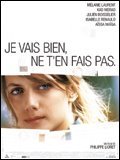
Je vais bien, ne t'en fais pas (2006)
1h40min
Director: Philippe Lioret
Screen writer: Philippe Lioret & Olivier Adam
Adaptation: Olivier Adam
With: Mélanie Laurent, Kad, Julien Boisselier
This is the type of film in which the scenarist kills the director, and since the scenarist of the film is also the director, then it appears to me almost a true suicide.
95 mins out of the 100, you sit in front of the big screen, cursing the director, and at the last 5 minutes, you fell in love with him thanking him for inventing such a beautiful cinematic language.
You watch the movie as you look at a mirror fallen apart, pieces spreading on the floor, you ask the director, "why do you have to accumulate so many useless details? why you are not advancing your story? where is the focus? why you keep sidetracking?"
When you almost lose all your patience to stay in the cinema, the plot turned finally at the last 5 minutes and the climax builds up and falls sharp in the last 20 second, and the film is over! You flahsed back what happened during these 100 mins like a vacuum cleaner sucking up the broken pieces of the mirror, and you realized the most insignificant bits are the essential tissues of the film.
What a trick the scenarist has set up for the director!
2 October 2006
The first Sentence
如,假寶玉第一次看到林黛玉時說︰「這個妹妹,我見過﹗」
Why is the first sentence so important? As a person, s/he impressed you and this image stays with you the whole life. As a book, it catches your interest, and you can never put it down until the last page. This is the craftmanship of writing. A powerful first line is a strong blow to its readers, and you may fall in love with the writer immediately as you may fall in love with a person.
How the writers open their books?
Ernst Hemingway starts from nowhere with this sentence: "Then there was the bad weather" in A Movable Feast. It was like a trap, you found yourself standing at the middle of the universe, across time, across geographical boundaries, without time without boundaries, because he breaks away from the rule of time, space and people.
Similarly, 莫言 in【生蹼的祖先們】 has his first character coming to the scene from nowhere, and the air is suspended, intriguing the readers to dig into it like a grave digger, "第二天凌晨太陽升起前約有十至十五分鐘光景,我行走在故鄉一片尚未開墾的荒地上。……我正在心裡思念著一個打過我兩個耳光的女人。我百思難解她為什麼要打我,因為我和她素不相識。」
Another way of open the scene is to start with an action, and this action is as banal as possible, but later you will see it as the core of the whole story. In Mrs Dolloway, Virginia Woolf starts with "Mrs. Dalloway said she would buy the flowers herself". This was a bomb to the literary scene when the book first appeared in 1925, not just in the sense that it focuses on a one-day-activity of Mrs Dolloway, but also the writing and this first sentence, which is so trivil that it bypassed the rhetorical announcement of all classical writings.
Talking about the great classics, nobody can forget the famous opening line from A Tale of Two Cities by Charles Dickens. "It was the best of times, it was the worst of times..." (see comment for complete quote). The power of this long first sentence is the doubleness, the pairing up, which was the theme and the structure of the novel, including London and Paris, Sydney Carton and Charles Darnay, Miss Pross and Madame Defarge, etc.
In Living to Tell the Tale, Gabriel Marquez starts with "My mother asked me to go with her to sell the house." and then the journey to sell the house evolved the story. The first paragraphy of the book is amazing, a friend said to me, "this is what makes a writer!" Yes, it's a beautiful paragraph, I am willing to be Marquez's typist for one time. Here you go:
"My mother asked me to go with her to sell the house. She had come that morning from the distant town where the family lived, and she had no idea how to find me. She asked around among acquaintances and was told to look for me at the Libreria Mundo, or in the nearby cafe, where i went twice a day to talk with my writer friends. The one who told her this warned her: "Be careful, because they're all out of their minds." She arrived at twelve sharp. With her light step she made her way among the tables of books on display, stopped in front of me, looking into my eyes with the mischievous smile of her better days, and before I could react she said: 'I am your mother.'"
How did I start my book? My first sentence is:
當時,奶奶是這樣對白妹說的︰「俺厝地址是福建省晋江縣陳埭鎮岸兜村前街祠堂邊第三塊厝。」
29 September 2006
Quartett - Heiner Muller and my nightmare
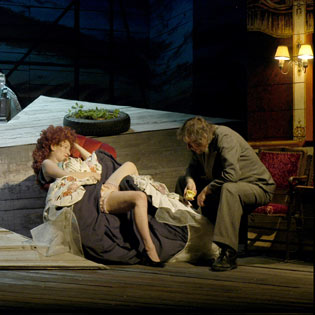 29 Sept 2006
29 Sept 200620h30
Conservatoire National Superieur d'art dramatique
D'après Heiner Müller
Mis en scene: Matthias Langhoff
Décor,films: Matthias Langhoff
Lumières: Frédéric Duplessier
Avec: Muriel Mayette, François Chattot de la Comédie-Française
Photo credit: Theatre de la Ville
"Don't ask me!"
-- This is not a theatre critique。
[Enter Selina A and Selina B]
A. I am sad.
B. Pourqoui?
A. Can you imagine how hard it is for me to take this?
B. Quoi?

A. Can you imagine how sad I am?
A. Can you understand my frustration?
B. Quoi?
A. No, you can't.
B. Pourquoi?
A. Nobody understands.
B. Quoi?
[ A pause.]
A [Laughs]. Nothing! [turns away from B, goes out]
[B stands alone, perplexed]
(light slowly out, music Q12, goes.)
It's a very powerful performance, in adoptation, in directing, in acting and I love the set design... and yet, I sat there, motionless, like an alient fallen from the outer space... can you just tell me what you are saying??
I am sad. I am sad and frustrated -- for me, I understood nothing! Why the language barrier is so high, so much higher than I imagined, too high for me to get over... I felt so helpless, so desperate... I can't understand what they are saying!!... I was a deaf in the auditorium. How much longer will it take for me to understand their langauge? their stupid french language!!??!!!
Hi? anyone there? anyone hear me??
27 September 2006
Sophie Calle
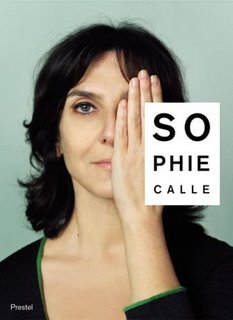
One of the most important and interesting figures of French contemporary art scene is Sophie Calle (b.9 oct 1953). Had seen the records and descriptions of her amazing works before but today was the first time I saw a real work of Calle, L'Erouv de Jerusalem.
Like her usual work, she plays with the ideas of memory and absence, privacy and public, intimate and voilence. In the installation, Calle asked the residents in Jerusalem to bring an object of their sweetest / bitterest memory to a public place during the Shabbat (a religious period when private and public domain is separated, i.e. no one and nothing can leave the house), and she photographied them with journals affixed to each personal memory.

Sophie Calle is the detective of urban life. In most of her works, she plays with the strangers from the streets, she is the writer, dirctor, actress and producer at the same time. She is a highly alert and inventive artist, the slightest flash or the most insignificant objects in life would become her inspiration. If you find the film Amelie Poulain (2003) amazing, you would find her work even more wonderful.
In Filatures Parisiennes (1978-80), she followed strangers in the street just like the 19th Century flaneur, she noted down their way and movements, and took photographical record of their activities, "not that I am interested in them, but just for the pleasure of following". In 1980, she followed a man all the way from Paris to Venice during 4 days, and this becomes the famous work, Suite Vénitienne (1980).

L'Hôtel (1981), she found a temporary job in a Venice hotel as a cleaner for 3 weeks. During the work, she observes and takes photos of the personal affairs, the rubbish bins, the left-over food, etc. of the hotel guests, and reconstructs their relationships, their life and their thinking.
Le Carnet d'adresses (1983), this is a very classic work of Sophie Calle. One day, she found by accident an address book in the street. She then contacted and met the strangers in the address book one by one with the aim to "reconstruct" the owner of the address book. At the end, an exhibition was organized, but it was finally closed down due to the objection of subject of the exhibition -- the address book owner!
Les Dormeurs (1980s), 24 persons were asked to sleep in her own bed in succession during 8 days, they came alone or with their lovers, slept quietly or talked before sleep, or dreamt a lot... Sophie Calle photographied their gestures every hour. One time, a sleeper didn't show up, so she had to be one of the sleepers herself.
Voyage en Californie (2003), the story of sleepers continues. In June 1999, an american boy called Josh Greene wrote to Calle asking if he could come to sleep in her bed in order to cure his broken heart. Afraid of an intrigue, she sent the bed with bedsheet and pillows to the boy in California. In Feb 2000, the boy sent the bed back to her when he was recovered.
 Damien Hirst (2003), Sophie Calle met Damien Hirst in 1989 in Glasgow. That evening of their first encounter, she asked him to write her a love letter. Later, she received a 5-page love letter from him, "a burning heart for a stranger". A year later, Calle wanted to interview Damien Hirst for her exhibition catalogue. However, she was too busy to do the interview that she asked him to makeup the questions that he imagined she would have asked him. The fictional interview was published. 12 years later, they reversed the roles, Sophie Calle asked Damien Hirst to interview her instead and he sent her a psychological test questionnaire for her and her family, the questionnaire with answers and test results were exhibited to the public in 2003 in Centre Pompidou.
Damien Hirst (2003), Sophie Calle met Damien Hirst in 1989 in Glasgow. That evening of their first encounter, she asked him to write her a love letter. Later, she received a 5-page love letter from him, "a burning heart for a stranger". A year later, Calle wanted to interview Damien Hirst for her exhibition catalogue. However, she was too busy to do the interview that she asked him to makeup the questions that he imagined she would have asked him. The fictional interview was published. 12 years later, they reversed the roles, Sophie Calle asked Damien Hirst to interview her instead and he sent her a psychological test questionnaire for her and her family, the questionnaire with answers and test results were exhibited to the public in 2003 in Centre Pompidou. Images:
26 September 2006
Esquisses de Frank Gehry (1)
 Documentary (2000-2005)
Documentary (2000-2005)Director: Sydney Pollack
26 Sept 06 16h36
UGC CITE LES HALLS
How do you feel when you look at the real buildings?
- Terrible! How could anyone allow me to do such a terrible thing. I want a place to cover up myself.
- From sketching to finishing, it takes such a long years to do a project. Too long, that when it's finished, i started to hate it.
- This building is one of my children, and this is the second time I see it. Maybe I would see it two or three times more in life, then, that's all...
How do architects work?

- From sketches, then paper models, then cardboard models, then digital models, then wooden models, then concrete buildings, then demolished....
Where do the inspirations come from?
- From wastepaper bin, from paintings, from a clip, from a fish....

Why you are so obessed with Fish?
- When human civilization can't advance, you have either to stop or to go back. And I choose to go back to millions of years ago when there is only fish!
- The day after seeing the fish sculpture model, the client called me, "Frank, we got a problem. You know, our clients pay thousand dollars to stay a night in the hotel, and we put them to look at the ass of the fish?!"
What is architecture?

- This is a concert hall, the auditorium is the most important, the others, are of minor importance.
- If the architectural presence distracts the spectators' attention, it's only that the paintings are not good enough.
Born in 1929 in Toronto, Frank Gehry was once a lorry driver, an airplane cleaner before he became known as Frank O. Gehry - the great architect. Graduated from Southern California University at the age of 25, he established his associate in 1963, at the age of 34. His artisitic view, however, was not gaining recognition from
 his contemporary at his young age. And he concluded that there was a anti-semitic sentiment against him, so he changed his name from Ephraim Owen Goldberg to Frank Gehry, to cover up his jewish trace.
his contemporary at his young age. And he concluded that there was a anti-semitic sentiment against him, so he changed his name from Ephraim Owen Goldberg to Frank Gehry, to cover up his jewish trace. Frank Gehry's work shows an influence from his modernist predecessor Le Corbusier, such as his Notre Dame du Haut. However, as a post-modern deconstructivist architect, Frank further breaks away from the symmetrical aesthetic and balance of modernist architecture. By creating anti-physics and lost centre-balance structures, his work were dominated with curves, visual conflicts, wraped walls, that they become
 unconventional but functional sculptures.
unconventional but functional sculptures. Selected works and images of Frank Gehry:
1. Vitra Design Museum, Weil am Rhein, Germany (1989)
(Photographer, Don Wong)
2. Frederick Weisman Museum of Art, University of Minnesota, USA (1990)
3. Disney Village, Disneyland Resort Paris, France (1992)

4. Cinematique Francaise, Paris, France (1994)
5. Dancing House, Prague, Czech Republic (1995)
6. Guggenheim Museum Bilbao, Bilbao, Spain (1997)
7. Walt Disney Concert Hall, Los Angeles, California, USA (2003)
8. Pritzker Pavilion, Millennium Park, Chicago, Illinois, USA (2004)
etc.

Official Website: Sketches of Frank Gehry
24 September 2006
港男與港女
在葉一知的blog上有文一篇,題為「港女」,為這個甚為一眾姐妹難堪的名稱具體闡釋一翻,很有趣﹗大家有時間不妨一click,看看這個港男如何理解「港女」。
剛剛在朋友M的blog上看到這樣的說法,很有意思。港男不娶、港女不嫁,大家互「瞄」,到底哪裡出了岔子?香港的兩性不溝通,到了廿一世紀依然有「一條龍」的女校、男校存在,簡直不可思議。試問在這些修道院般的學校生存七年甚至十九年,大家又何以知道對方正在想些甚麼?當然,即使是男女校混出來的,也未必就能溝通兩性,這又涉及第二個「詞彙表達」的問題。少男少女交談喜歡用俗語,說話隱晦曖昧,「冧」、「溝」、「界」之類的動作,毫無誠意,時間上亦不允許有溝通的存在或可能性。「心照」啦,所以就不用說話了。
如是者,朋友M說,港男和港女在這個進化過程中,相去甚遠,形象越來越模糊,最終連一眼也看不上了。
以下是朋友M (In Love with Change) 的一段文字,抄下來和大家分享,希望m不要介意。
「現代女性的悲哀是,幸褔這一個看似簡單的願望,偏偏這麼近,卻又是那麼遠,令人無限欷歔。也許幸褔是一件很玄妙的東西吧,愈想得到,卻愈得不到。它有時伸手可及,只是我們愈走愈遠。聽過不少女生慨嘆現今男人質素差,愈來愈配不上她們。 坦白說我並不完全茍同 - 會不會只是大家在進化過程中沒有認清彼此的期望,然後雙方愈走愈遠? 很愛用"the best is yet to come"這句話鼔勵失意的朋友。我常想,如果大家嘗試,總可抓着一些小幸福吧。人生,總會有奇妙的意外 . . .」
23 September 2006
Je vais promener ma tortue...
An article entitled "The Art of Doing Nothing – And nobody does it better than the French", appeared in the Washington Post on 13 August by an American correspondent in Paris, Joel Achenbach. It's a highly entertaining piece not only in the witty choices of images and words but also the very juicy complex of American admiration, jealousy, frustration and fear towards its "eccentric" French counterpart.
If Paris is the city the world literature has been writing about the most, I dare to say no one single nation has been depicted and stereotyped by its fellow nations as much as the French has been. Why the world is so obsessed with France? Why do the French appear so enigmatic to the rest of the world? And why they are never tired of this role?
Is it the result of decades or even centuries of advocacy of French high culture? Is it the language that beyond our daily comprehension which makes it even more exotic? Is it the long-lived spirit of crazy philosophers and fervent revolutionists that crystallized in the French blood? Is it the almost impossible survival of a humanity society in today's world economy that renders it even more mythical and legendary? We knew well that after the WWII, the French no longer fancy themselves as the biggest or the strongest power in the world, but they still believe they are the best. Is it simply this overflowing national pride that made them the most culturally confident beings among the nations?
"Em… there is only one reason, because I am a French!"
The article can be read as a general American impression of the French. You can almost imagine a Washingtonian reading this article laughing his jaw to the ground! In Washington, the French are criticized as provocative, whimsical, pushy and self-important. This is the image the French has built since the era of de Gaulle. On the level of international politics, France is always playing a discordant tune to the American policy. Such as during the cold-war time, France's amity towards China and the U.S.S.R. had cold-sweated the American government. Again, in the 2003 UN resolution on the Iraq war, France was the only country that stood against the America though it was not the only one opposing the war. On the international stage, unlike the British whose foreign policy has been closely on line with the America, France remains independent and assertive (partly because they love the art of debate and partly because they like to speak for the others). For most part, France has gone its own way in the world, posting France as an alternative to the others. And this makes the French eccentric in the American eyes. As for the Chinese, it's always entertaining to look at the cock and the eagle pecking at each other's feather!
Back to the article, this title is itself highly stereotyping and therefore entertaining. A very witty choice of the word "art", the image of a sophisticated and pretentious French dandy pops up on your screen. Everything happens in Paris, as far as it's executed by a French, the glorious halo of art immediately endowed itself to the act, even doing nothing in a café. So there is the art of drinking wine, the art of making baguette and cheese, the art of toddling in a Sunday-morning-dog-shitted-street, the art of crushing into an overcrowded metro wagon and ignoring the screams from inside, the art of kissing in the street as if no one is around… I would love to read an article entitled "The Art of Pissing in the Street – and nobody does it better than the French". Isn't it even more attractive?!
Doing nothingness
Behind the mysterious act of Doing Nothing, there is this very unique French concept of time which is elusive to the Americans, i.e. the visualization of la durée, the duration, or the process. It is the sense that time is suspended at the moment when they are doing nothing, i.e. the time passed in time's most concrete form. When we are engaged with a particular activity, time is translated into that act. The existence of time is experienced through the action. However, at the very moment of relaxing, time is peculiarly chopped up, this moment, la durée, is different from the previous ones and the following ones.
In the 19th Century Paris, there existed this group of anti-social beings called les flâneurs. When the whole society was undergoing a series of industrial and capitalist transformation, when time is translated into productivity and money, these flâneurs strolled in the city in idleness, doing nothing but walking, observing, thinking and silently protesting against the other's industriousness. Sometimes, they spied a certain person and followed him/her the whole day; sometimes they took adventures by following a scrap of paper which they gave to the wind to play with, like the hero in Duma's Mohicans de Paris. Around 1840, it was briefly fashionable to take turtles for a walk in the arcades. The flâneurs liked to have the turtles set the pace for them. If they had had their way, progress would have been obliged to accommodate itself to this pace. Fortunately or unfortunately, this attitude did not prevail.
In the art of flânerie, is that the flâneurs demanded elbowroom and were unwilling to forego the life of a gentleman of leisure. So, here comes the second very frenchy concept: the idea of doing things elegantly without hurry. This explains why the French against the American fast-food culture, against the instant coffee, against wal-mart. Since in them, gracefulness is simply absent.
It's quiet a taboo to eat while walking in a Parisian street, in some up-class chic quarters, even having an half-bitten apple in your hand makes you indecent. There is no economic discrimination here, but the discrimination is upon the manner. You can grasp a sandwich or whatever from a street hawker, just don't eat in the street. Sit down in a park, or a bench, or a fountain and enjoy your food!
It's however true that some of the French elegancy is lost in the decades, and the haut couture designers are lamenting for the lost. Today’s France is absorbing (not "assimilating" as the French imagined themselves) its Arabian immigrants' sub-cultures, the American pop culture and the African primitive cultures. The young French dressed casually, not very different from the American or Japanese teens. But the so-called elite class (yes, despite their belief in democracy and equality, the French admired and entrusted their power to the elites class), keeps their norms. Can you imagine a boy elegantly dressed with a pair of shinning leather shoes appear in the campus of HKU or UST? You must have asked with a what-a-pity look on your face, "is he gay?" Yeah, yet French boys in prestigious schools like it… "Why do you dress up like going to office?" Once I asked a 23-year old architectural student, and he said, "Because I am used to it", this sentence can be interpreted as "this is my style", "I was like this since very young". No wonder this boy comes from a middle-class family and he is trained up like this. To be elegant, to him is also a sign of being mature and professional, and he likes this.
Sitting in a café
Sitting in a café is not necessarily a French pastime. I like sitting in a café as well… everyone likes it. But some people feel at ease with just sitting there and doing nothing, some others feeling uncanny when they have nothing to do, the later is the case for the writer. He failed to appreciate la durée and the elegance. He also failed to realize the sweet solitude of being alone at the middle of the crowd. What the French really mastery is this secret mental technique. They are there to look and to be looked at, they might secretly dream for une belle rencontre, a sweet encounter, but they enjoy better their own beautiful imagination that flashed through their mind, since une belle rencontre doesn't happen too often.
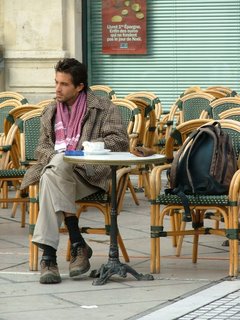
One of the important factors between the seeing and to be seen, is that there exist a discretionary distance between the subjects and objects. It is this safe distance that keeps the action of looking possible. Proximity suffocates this relationship. The best example is the passengers in the metro, they always carry a book and read in the metro. Yes it's a better use of time, but it's also a very clever way of avoiding eye contact. We sit in the metro in a strange position of looking at each other for longtime without speaking to each other. This feeling is equally uncanny. Reading becomes a way of avoiding eye contacts when the discretionary distance is impossible.
Sexual politics
If we know each other in this modern society as debtors and creditors, salesmen and customers, employers and employees, and above all as competitors; for the French, they first thing they see in each other, is as man and woman, then attitude and role-play will be appropriated and adjusted accordingly. Sometimes I suspect this as a reflex act of their feminine / masculine rules in the french noun.
The man-woman relationship is a huge topic in
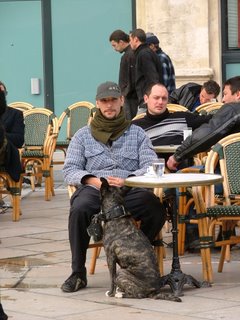 France. It applies to all social scenarios and amplifies itself to the cover all sorts of interpersonal dealings. Just to give some trivial examples, a 5-year old girl was playing football with her friends in Jardin du Luxembourg, she kicked her toe on the ground and was hurt. A boy of 8 came and performed neatly this ritual: he gave her a hug first, then kneeled down on the grass, kissed her toe! I was stunned. I would marry anyone who kisses my toe in a garden!! Who taught him this? And who taught the little girl to give the right response of stop panicking?
France. It applies to all social scenarios and amplifies itself to the cover all sorts of interpersonal dealings. Just to give some trivial examples, a 5-year old girl was playing football with her friends in Jardin du Luxembourg, she kicked her toe on the ground and was hurt. A boy of 8 came and performed neatly this ritual: he gave her a hug first, then kneeled down on the grass, kissed her toe! I was stunned. I would marry anyone who kisses my toe in a garden!! Who taught him this? And who taught the little girl to give the right response of stop panicking? Another example, a father is playing with his 3-year old coquettish daughter. He sat her on his legs and held her to him, nose to nose, asked her, "do you love me?' she giggled and replied proudly, "no!" The father dropped her almost to the ground and she was excited by the suddenly fall. Then they repeated the game of "do you love me?" and "no!" This little girl is now well trained to get what she wants from a man by pretending to refuse him her love!
And a third example: a female driver was stopped by a police and instead of interrogation, they started a chat. After 10 minutes talk, you can tell from their facial expression that the temperature of the chat was increased to become a flirtation. The spot was L'Opera, it was 18h, date forgotten… if you want to report the policeman!
As for the writer, he's quite right to know his existential mistake if he talked to the Frenchman. The reason is not his level of French or his impoliteness, but his irrevocable truth of being a man.
The writer also assumes that all Frenchmen are married and all of them have a list of mistresses. Every woman is wife to somebody and mistress to many others! Isn't this pure male fantasy? An imagination of the most impotent? The point is why they put the label on the French foreheads? Because they are all "Sartre and Simone de Beauvoir"? Because according to a whatever research agent, the French rank number 1 in satisfaction of sex life? Because they are all elegant creatures "modeling for Toulouse-Lautrec"? Because they are not "multi-tasked" when they are in bed? Because they won't ask, "why did you not try to achieve something?" when they are having a post-love scene relaxation?
In his scandal with Lewinsky, what Clinton must be regretful was not what he has done but that he wasn't born a French. Should he had been a French president instead, he would just have said, "after all, I am a man" and he would be able to get it passed. The French did find the reaction of the American politicians and the public in general ridiculous. "What's the point of making a fuss over a mistake in one's private life?! Look, our former president Mitterrand appeared from time to time before the camera with his mistress and their daughter, and we love him all the same!" This is why all men in the world are so obsessed with France! The country guarantees sexual freedom... So, all French are stereotyped as infidel. There is a Madame Bovary in every French woman and a Don Juan in every French man! How far is this true?
Opposing this infidel image, there is this image of French as passionate lovers who are ready to die for love. Love values high in the social system, everything will be self-justifiable under the sacred name of Love. It's insane for the Chinese government to imprison a Chinese girl who's in love with a French diplomat in the early 1980s, it's unreasonable to assign lovers to work in different cities... So, my French brother-in-low made a rhetoric announcement: I love my wife, so I follow her everywhere in the world! It's very true in what he said, just that no one but the French would love to make their passion seen and heard, including to those who are not concerned with. That's why the French are romantic, so to speak, to lots of Asians. They see a Cyrano de Bergerac (大鼻子情聖) in every Frenchman. However, if I tell you that the divorce rate in France is 33%, i.e. one divorce in every 3 marriages, would you now find them scary?!
Whether they appear to you as Don Juan or Cyrano de Bergerac, each of them is, after all, unique, just like you and me as unique Chinese or Hongkongais, or simply a planet citizen. Stereotyping can be light-hearted and entertaining when it doesn't mean harm, but it melt away when things come to a personal and individual level. The key to a meaningful and beautiful cross-cultural encounter is to empty oneself from his/her own cultural prejudices, so that one would be able to merge deeper into the new culture, and be able to see the beauty inside the others. This is how we get to know this world.
The Art of Doing Nothing
-- And nobody does it better than the French
By Joel Achenbach (Washington Post, Sunday, August 13, 2006; Page W11) In Paris, you sit in the cafe, like Sartre and Simone de Beauvoir. Sitting in a cafe is one of the main activities in Paris. It's what Parisians do instead of working or jogging. They have a natural talent for it, the way Americans are good at going to the pool, grilling meat or driving interstate highways. Read Joel Achenbach weekdays at washingtonpost.com/achenblog.
The crucial skill in a cafe is the ability to gear down, from second to first, and then down yet again to a special, Gallic gear that is nearly paralytic. It's a bit like being dead, but with better coffee.
The chairs in the cafes are lined up in rows, facing outward, toward the theater of Paris street life. Or perhaps it is the patrons who are on display. Their posture says: Here, look at us, full in the face, as we sit in the cafe so brilliantly, thinking our big French thoughts.
Like the other day, I was nursing an expensive thimble of wine in a cafe on the Rue de Something, near the Avenue des Whatevers, and to my immediate left sat a Frenchman in a pose so relaxed he might have been modeling for Toulouse-Lautrec. He was doing nothing, and doing it with panache. Between two fingers dangled a cigarette that remained lit even though he never did anything so animated as puff. It was hard to tell if he was truly drinking his glass of red wine; the level went down so slowly it may have been merely evaporating.
Why did he not try to achieve something? The café advertised WiFi, but no one had a laptop. This was not Starbucks. There was no American compulsion to multitask, to use the cafe as a caffeination station and broadband platform for another increment ofaccomplishment.
Conceivably I could have spoken to the Frenchman, but the language barrier is significant; I am afraid to attempt anything in French in a cafe lest it be incorrect both grammatically and existentially.
Perhaps the Frenchman was dreaming up an elaborate sociohistorical theory, positing that human civilization has been in decline since the invention of the croissant. Or perhaps he was just enjoying the Latin Quarter, a section so old that I am pretty sure its residents still speak in Latin. The nearby Notre Dame Cathedral was built in the Middle Ages, when the European idea of comic relief was a stone gargoyle.
Parisian commerce is quaint, which is to say, hopelessly inefficient, requiring that shoppers pay the equivalent of a charm tax. You go to one little market to buy your cheese, another to buy your jalapenos, another to buy your corn chips, another to buy your salsa; only then can you make nachos.
I had an urge to blast the Frenchman out of his reverie. "Excuse me, I'm from Wal-Mart," I could say. "We're putting in a superstore right over yonder on the Rue Dauphine. Gonna kick some serious retail derriere, ya dig?" Then, as though he could hear me thinking, the enervated Frenchman finally did something: He looked at his cellphone. Action in the cafe! He didn't make a call, let's be clear on that, but he studied the cellphone. It dawned on me: He was going over all the speed-dial listings of his mistresses.
Now we're getting down to business. Sure, he ponders the big Frenchy thoughts as he camps in the front row of the cafe, but he's also scoping out the Parisian femmes, who are tres magnifique! That is French for "bodacious." These women tend to be slinky and stylish and sophisticated, and they make American women look, by contrast, as though they just fell off a hay wagon. The femmes have an air of saucy liberation. You can imagine that they are writing Volume 4 of their projected nine-volume encyclopedia on les artes erotiques. They're on the chapter about the webbing between the toes. That lovely muscle tone in the upper arms? That's from all the time they spend on the trapeze. (Conceivably this is a projection from the tourist's subconscious: We've seen those subtitled films where a layabout Frenchman does nothing but smoke cigarettes and all the women take off their clothes.)Eventually, I reached the obvious conclusion that the man beside me was a professional sensualist. It's a job that doesn't exist in America outside of certainZip codes in California. For the sensualist there are long recessions, even depressions, as the economy of romance goes into a dive. One sits in the cafe and hopes for an upturn in the market.
I sympathize: It's hard work. A grind, at times. But it sure beats the heck out of doing nothing.
22 September 2006
Le Grand Inquisiteur
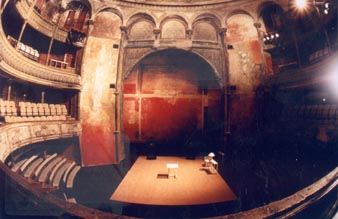
Le Grand Inquisiteur
22 Sept 2006 (21h - 22h)
Theatre des Bouffes du Nord
Mise en scène: Peter Brook
De: Fedor Dostoïevski
Adaptation: Marie-Hélène Estienne
Avec: Maurice Bénichou & Ken Higelin
Le Grand Inquisiteur in Book 5 of Les Frères Karamazov (卡拉馬助夫兄弟們)
坐在這個古舊的劇院內等開場,突然有點感動。這是整年來第二次踏進劇院看戲,是從哪裡來的勇氣,何以忽然認為自己會聽得懂?可能太久沒有踏進劇院,人開始感到失落。
可是我做了一個錯誤的選擇。看到是 Peter Brook的戲,心想81歲的老人家為你導戲,你還有甚麼藉口可以錯過了?但我應該知道,這將又是一個文本極重的演出,法文,這個門階依然踏不過去。結果,全力以赴地聽了十五分鐘,集中力開始不行了。加上 Dostoïevski 的名作 The Brothers Karamazov (1879-1880)也沒看過,對於這一節對宗教、自由和人性的大審判也不甚了了,結果亦只能脫離文本,做看戲應做的事 -- 看、看、看。
舞台是一貫的空蕩蕩,只有一張約 3 m x 2 m 的 5吋高灰色platform,台右上 放著一張黑色圓形小本凳,platform邊的台左下位是另一張凳。燈火是維持不變。身穿黑色長褲長衫的Alyosha / Christ 從左邊觀眾席走到台左,坐下,赤腳。黑色長褸長褲的Ivan / Inquisitor 從台右幕進場,站在台右,舞台呈對角線,焦點集中在兩人的距離。
無神論的哥哥Ivan 開始給忠於宗教的弟弟Alyosha說故事,The Inquisitor質問耶穌為何要再一次出現在人群中,阻礙著教會的工作。他以耶穌拒絕撒旦的三次誘惑 (The temptation of Christ) 而換取自由的故事來證明耶穌錯了,並且不應在這個時候 (十六世紀)再次出現。人性是懦弱的,而人是愚昧的,耶穌誤信了人類,給予人自由選擇的權利等於剁奪了他們受苦贖罪的機會,人類只有永遠的苦難。只有透過撒旦式的死亡和毀滅,人類才能在無知的快樂中結束這個永久的苦難。而 The Inquisitor 及教會將會負起這個撒旦式的責任,所以,「這裡沒有你的事了,我現在命令你離開這裡。」
Christ 站起,45度走向台右上,親吻了The Inquisitor,再45度向台右下離開舞台,路線剛好呈一個三角形,亦即天主教中的 trinity。這是演員在整個演出中唯一的動作。The Inquisitor 呆坐在那裡,這一吻彷彿在他心裡蕩起了愛,但他依然選擇隨著他的想法走向死亡。
一個小時的密集式獨白,結集哲學和神學爭辯,真夠我受了。只記得不斷聽到 conscience 和 liberte這個字。看戲也看觀眾。我坐在山頂,是觀察別人的最佳位置。開場不到十分鐘,已有五分一觀眾合上了閉目 -- 是深思?是養神?只他們自己才知道了。
21 September 2006
Les enfants du monde
Photography exhibition
Outside Jardin du Leuxembourg, Paris
Presented by The Senat, France
Photo courtesy: © Kevin Kling
看完這個展覽和我自己拍下的小孩,我突然發現,原來,三歲以後的小孩,就已不再是我們想像中的那個天真無邪的快樂小天使。在貧窮落後的地區,小孩們的眼睛總透露著生活磨練出來的早熟和苦難感,他們總是帶著幾無奈的表情,一副小小年紀便看破紅塵的模樣。而在先進的國家,小孩的早熟表現在那種被世俗過早同化的,小小年紀便懂得看人家眉頭眼額,人情世故,即所謂的「老積」或「老人精」。
所謂的「童瞳」,只有小孩跟動物相處才看得見了。
20 September 2006
Rodin et les danseuses cambodgiennes
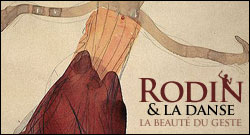 Rodin et les danseuses cambodgiennes,
Rodin et les danseuses cambodgiennes, -- sa dernière passion
Date : 16 June – 17 Sept 2006
Venue : Musée Rodin de Paris
Photo courtesy : Musée Rodin de Paris
In 1906, the pro-France new King of Cambodia paid a diplomatic visit to France. Coming with him were the Cambodian court dancers who performed for the French audience in Marseilles then in Paris. In the auditorium, there was the famous 66-years old sculptor, Augustine Rodin. Enthralled by the Cambodian dancers, Rodin made an immediate decision of following them to Marseilles where they would soon be boarding the return ship to Cambodia. Within a few days, this old artist had produced around 150 watercolours of the Cambodian dancers. This collection was so precious to him that he sold scarcely, gave only a few to his friends but exhibited a lot to the public. In the years to follow, he painted for Najinski and Hanako, and produced impressive sculptures after them. The dancing body series became known as the great sculptor's last passion.
 As a sculptor, Rodin spent his whole life in capturing the corporal beauty in our daily life. The way we sit, we walk, we lay down; the way we kiss, the way we think, the way we suffer; the way our bodies were distorted by pain, by sorrow, by fear... To him, the soul is not trapped inside the human body by the body as the most ardent medium for the manifestation and emancipation of the abstract form. His sculptures captured this very moment of expression where our soul becomes visible in flesh and blood. There are vitality and balance in the gestures, emotions and desires in the facial expressions, harmony and energy in the muscles. Rodin's work mainly based on daily expressions of the body, and in these most common life context, he found the beauty of the bodily expression and developed his aesthetic sense in his sculptures. Therefore, these expressions are genuine and shared by all of us, real to life and human nature.
As a sculptor, Rodin spent his whole life in capturing the corporal beauty in our daily life. The way we sit, we walk, we lay down; the way we kiss, the way we think, the way we suffer; the way our bodies were distorted by pain, by sorrow, by fear... To him, the soul is not trapped inside the human body by the body as the most ardent medium for the manifestation and emancipation of the abstract form. His sculptures captured this very moment of expression where our soul becomes visible in flesh and blood. There are vitality and balance in the gestures, emotions and desires in the facial expressions, harmony and energy in the muscles. Rodin's work mainly based on daily expressions of the body, and in these most common life context, he found the beauty of the bodily expression and developed his aesthetic sense in his sculptures. Therefore, these expressions are genuine and shared by all of us, real to life and human nature.
It might be easy to understand a sculptor's search for inspiration in dance. However, Rodin has a very different view on dance from that of Degas. The stage can be fabulous and the dancers magnificent, but they are not everyday life. For Rodin, the body is the spontaneous articulator of the nature, for Degas, the body is the trained interpreter of civilization.
 Why then should Rodin be so fascinated with the Cambodian court dancers? This highlights the differences between the western and eastern concept of bodily aesthetics, and the dances embody these difference concepts: the classical ballet is airy, the Cambodian dance earthy. With bare feet, bent knees, outspreaded legs, firm steps on the ground, the Cambodian dancers were attached to the gravity, they are stable and neat. Their bare arms moved in the air in sharp and neat movements, mediated with momentary pauses. From shoulders to the fingertips, the many angular lines gave each part of the muscle its own presence.
Why then should Rodin be so fascinated with the Cambodian court dancers? This highlights the differences between the western and eastern concept of bodily aesthetics, and the dances embody these difference concepts: the classical ballet is airy, the Cambodian dance earthy. With bare feet, bent knees, outspreaded legs, firm steps on the ground, the Cambodian dancers were attached to the gravity, they are stable and neat. Their bare arms moved in the air in sharp and neat movements, mediated with momentary pauses. From shoulders to the fingertips, the many angular lines gave each part of the muscle its own presence. The Cambodian court dances derived from religious ceremony and it maintained lots of imaginary gestures of Gods’ power and human being's fear and worship for the power. Many of the dances are the stories between God and man and the gestures the mimesis of God and man's communication. The eastern religion might be ungraspable for Rodin, what he saw is the liberation of the human bodies in the everyday encounter
The Cambodian court dances derived from religious ceremony and it maintained lots of imaginary gestures of Gods’ power and human being's fear and worship for the power. Many of the dances are the stories between God and man and the gestures the mimesis of God and man's communication. The eastern religion might be ungraspable for Rodin, what he saw is the liberation of the human bodies in the everyday encounter  with religion. Unlike Classic Ballet which sees bodily beauty in the inhuman perfection of graciousness and purity, the traditional eastern dance seeks the relationship between the soil and body.
with religion. Unlike Classic Ballet which sees bodily beauty in the inhuman perfection of graciousness and purity, the traditional eastern dance seeks the relationship between the soil and body. This very opposing bodily view of eastern traditional dances found their western comrades in Isadora Duncan and Loïe Fuller, the two great creators of new dance and founders of modern dance. No wonder, Rodin would be equally amazed with their arts, only if they have had a chance to meet each other.














